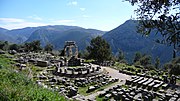Monument of Aemilius Paullus
The Monument of Aemilius Paullus was erected in the Sanctuary of Apollo at Delphi shortly after 167 BCE in order to commemorate the Roman victory over King Perseus of Macedon at the Battle of Pydna. It incorporated an incomplete pillar originally intended as a base for a portrait of King Perseus, which would have established the Macedonian presence in Delphi and reminded the Delphians of the tradition of friendship between them and the royal family. Aemilius Paullus repurposed the king's monument to celebrate himself and Rome's victory, noting that "it was only proper that the conquered should give way to the victors." The Monument of Aemilius Paullus stood in front of the Temple of Apollo along with two other commemorative pillars to Eumenes II of Pergamon and Prusias II of Bithynia. However, this pillar dominates over the other two. The completed monument had a bronze equestrian statue that sat on top of a rectangular pillar over 9 meters high. Although the bronze statue that originally sat atop the pillar no longer remains, the cuttings in the plinth show that the horse would have been in a rearing position. An inscription at the base of the pillar survived, L(ucius) Aimilius L(uci) f(ilius) inperator de rege Perse / Macedonibusque cepet, which translated, reads, "Lucius Aemelius, son of Lucius, Imperator, took it from King Perseus and the Macedonians."








